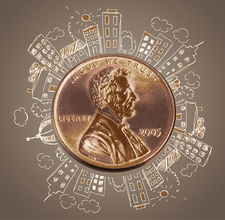A good cents exit survey
A Penny for Your Thoughts

© Lead Image © olegdudko, 123RF.com
Get feedback for live events with an exit survey that counts pennies.
To generate useful feedback for live programs at the Fort Worth Museum of Science & History's Noble Planetarium on the campus of Central Texas College in Killeen, Texas, we conceived, designed, and built a custom feedback system centered around pennies. The goals were (1) ease of use for both guests and staff, (2) a fast participation process, and (3) immediate feedback to the presenters and managers.
The Guest Experience
When you attend a planetarium show at the Noble Planetarium, you are handed a penny on the way into the theater. As a part of the show, we ask you to hold out the penny at arm's length and imagine that you are looking through Abraham Lincoln's eye. That approximates the field of view of the Hubble Space Telescope, which is the frame of reference for the remainder of the program.
As you exit the theater, the presenter has rolled out an interesting device that looks sort of like a coin bank (Figure 1). You are invited to return the penny in one of five slots to indicate how much you liked the show. As the pennies are returned, they are tallied by the machine; once everyone has exited, the presenter submits the counts, which are immediately visible on an internal web page.
[...]
Buy this article as PDF
(incl. VAT)
Buy Linux Magazine
Subscribe to our Linux Newsletters
Find Linux and Open Source Jobs
Subscribe to our ADMIN Newsletters
Support Our Work
Linux Magazine content is made possible with support from readers like you. Please consider contributing when you’ve found an article to be beneficial.

News
-
Say Goodbye to Middle-Mouse Paste
Both Gnome and Firefox have proposed getting rid of a long-time favorite Linux feature.
-
Manjaro 26.0 Primary Desktop Environments Default to Wayland
If you want to stick with X.Org, you'll be limited to the desktop environments you can choose.
-
Mozilla Plans to AI-ify Firefox
With a new CEO in control, Mozilla is doubling down on a strategy of trust, all the while leaning into AI.
-
Gnome Says No to AI-Generated Extensions
If you're a developer wanting to create a new Gnome extension, you'd best set aside that AI code generator, because the extension team will have none of that.
-
Parrot OS Switches to KDE Plasma Desktop
Yet another distro is making the move to the KDE Plasma desktop.
-
TUXEDO Announces Gemini 17
TUXEDO Computers has released the fourth generation of its Gemini laptop with plenty of updates.
-
Two New Distros Adopt Enlightenment
MX Moksha and AV Linux 25 join ranks with Bodhi Linux and embrace the Enlightenment desktop.
-
Solus Linux 4.8 Removes Python 2
Solus Linux 4.8 has been released with the latest Linux kernel, updated desktops, and a key removal.
-
Zorin OS 18 Hits over a Million Downloads
If you doubt Linux isn't gaining popularity, you only have to look at Zorin OS's download numbers.
-
TUXEDO Computers Scraps Snapdragon X1E-Based Laptop
Due to issues with a Snapdragon CPU, TUXEDO Computers has cancelled its plans to release a laptop based on this elite hardware.

